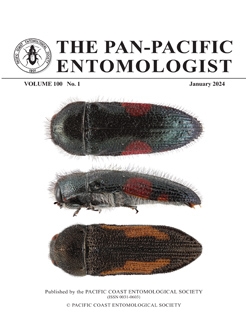Paul G. da Silva, Ted C. MacRae, Nathan E. Rank, Vincent H. Resh, Catherine A. Tauber, Robert L. Zuparko
The Pan-Pacific Entomologist 100 (1), 1-23, (27 March 2024) https://doi.org/10.3956/2024-100.1.1
KEYWORDS: Entomological journals, History of Entomology, entomological societies, scientific publications
We surveyed numbers of The Pan-Pacific Entomologist published from 1924 to 2023 for characteristics of issues, authors, topics, and study sites. We verified continuous publication, with numbers of articles and pages peaking in 1973 and 1981, respectively. Approximately 70% of authors and study sites were from California and the western United States. Insects from the five largest orders made up over 80% of the taxa of emphasis, but almost all insect orders and a wide variety of other invertebrate groups were represented. Taxonomy and natural history composed over 70% of the principal topics, followed by book reviews, faunistic studies, economic entomology, physiology/anatomy, and biography/obituary. Topic diversity increased steadily over time. Numbers of authors from the Neotropical and East Palearctic biogeographic regions increased markedly in the last four decades, as did the numbers of study sites from the Oriental, East Palearctic and Oceanian realms. Some observed changes in the journal's characteristics over its century of publication may reflect local, national, and international trends, such as increased collaboration among researchers, altered scientific opportunities and constraints, heightened awareness of societal and environmental problems, and page charge considerations. Our analysis suggests that the journal has increased its geographic range and currently reflects a broad diversity of international entomological activity. At the same time, by retaining the essential characteristics of a regional entomological publication, it has continued to encourage local research and strengthen personal interactions within the local community. Similar analyses of other long-standing regional entomological journals could prove valuable in interpreting the results presented here.

